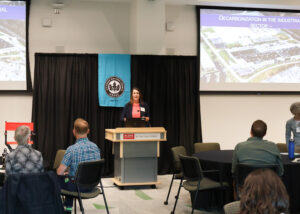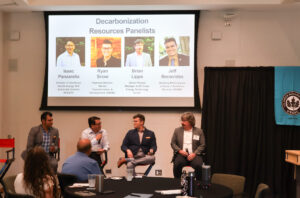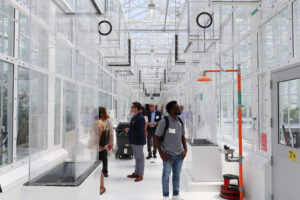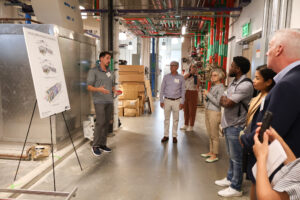USGBC Industrial Decarbonization Forum at NC State University
By: Isaac Panzarella, Associate Director
The U.S. Market Transformation & Development team at U.S. Green Building Council organized a forum on Industrial Decarbonization that was hosted by NC State University’s Plant Sciences Building on June 12, 2024. I became a LEED certified expert early in my career as an engineer, so I really enjoyed reconnecting with my roots in sustainable building design and construction. As Director of the U.S. Department of Energy’s Southeast Onsite Energy Technical Assistance Partnership, I was also excited to learn more about some industrial projects that are implementing onsite energy as a decarbonization strategy to meet their sustainability goals.

Diane Coleman, the Carolinas Community Market Manager for USGBC Forum kicked off the event that featured what manufacturers are doing to decarbonize and USGBC’s efforts to support building decarbonization in the sector. Diane introduced Stephanie Young, Vice President of Client Solutions at USGBC, who shared an update on LEED Version 5 development. A public comment period just completed and work will take place over the next year to finalize the new certification program. New aspects of the standard will drive the industry towards decarbonization on all fronts; ultra-low carbon operations, embodied carbon of materials and in buildings, both existing and new. About the manufacturing sector, Stephanie said that learning from certification of industrial projects has helped inform the new standard, while making a huge impact in not only energy, but quality of life, heath & occupant experience, resilience and social equity. For new construction LEED V5 will have a prerequisite for a carbon assessment covering the life cycle of the building. In addition to energy performance credits, there is an energy prerequisite for no onsite combustion. The V5 certification will favor location selection and transportation proximity, including compact development that is transit oriented and supports electric vehicle use. Another standard in development is LEED Zero Carbon, which will help existing buildings achieve net zero carbon emissions associated with energy use.
A highlight of the day was a LEED and Net Zero Project Showcase Panel during which panelists shared their experience with real-life projects. First to present was Darla Rivera, senior environment health and safety engineer for FUJIFILM Diosynth Biotechnologies. Currently FUJIFILM is building a new campus in Holly Springs, North Carolina that will have 1 million square feet spread across 5 buildings and aiming for LEED Gold certification for each building once completed. The project is about 72% complete on construction, with onsite energy generation, including 1.9 MW of rooftop solar and an adjacent 125 MW solar facility. There are natural gas fueled boilers and FUJIFILM are looking into sourcing renewable natural gas for fuel in the future. There is a goal of 42% potable water reduction, partly supported by the Town of Holly Springs reclaimed water system and a water recycling system. Composting of food waste onsite is a measure that will be implemented during occupancy, and FUJIFILM has already diverted 14,000 pounds of waste during 1.5 years of construction. Darla Rivera shared some good advice that the earlier you commit to sustainability, the cheaper it becomes. Building good habits and sustainability into the project makes it easier to meet your objectives to be carbon neutral.
Catherine Sheehy, the ESG & PBC Transparency Director for United Therapeutics Corporation presented on a recent project to build a manufacturing facility and warehouse on their company’s Research Triangle Park campus. The decarbonization strategies in the building and systems designs include implemented reduced energy use by 31% over conventional warehouses. One key technology is a geothermal heat pump system with 40 closed loop wells at a depth of 500 feet, providing efficient heating and cooling for the project. There is no fossil fuel or diesel backup for the facility, eliminating onsite combustion related emissions. An onsite energy microgrid generates renewable energy while providing power resiliency, with 560 kW of solar PV and 767 MWh of battery storage.
Matthew Pait, the Energy and Water Conservation Manager for the U.S. EPA Research Triangle Park campus, shared some insights from the perspective of managing and evolving an established facility. Among the 1.2 million square feet of buildings on the campus is the National Computer Center which is LEED Silver Certified (2005) and an Administration Building addition (2015). They have 500kW of solar PV arrays and are looking at developing additional onsite energy resources and electric vehicle charging infrastructure.
Dennis Pilarczyk, Manager of Building Solutions, Construction Solutions for Nucor wrapped up with an overview of his company’s offerings to support sustainable building construction. Nucor has a long history of recycling steel, and some products have 100% recycled content. Nucor is building a new factory in Brandenburg, Kentucky that is on track to be the 1st steel mill to be LEED 4.1 certified.

Two NC Clean Energy Technology Center team members were part of an afternoon Decarbonization Resources panel; Brian Lips, Senior Policy Analyst sat as a panelist and I moderated the discussion which also included Jeff Benavides and Ryan Snow from USGBC. We had a great exchange that revealed some new resources and developing partnerships that will support expansion of sustainable buildings. One of these efforts is a focus on working with upstream investors in building developments to establish environmental performance as a value in the early stages of a project. Another is an ongoing performance at scale initiative that is driving portfolio- and organization wide investment and innovation in green building.

The morning wrapped up with a tour of the LEED Gold Certified NCSU Plant Sciences Building that opened in 2022. The staff provided a well organized and thoughtful experience for participants and I highly recommend taking a tour if the opportunity arises. See this link for more https://cals.ncsu.edu/
